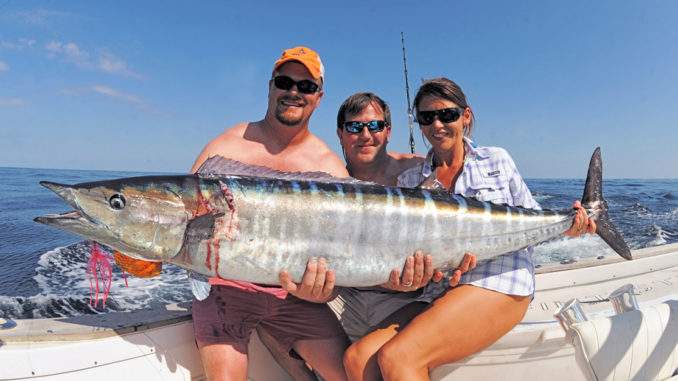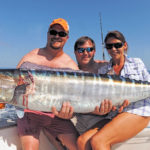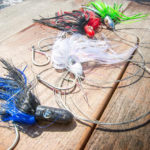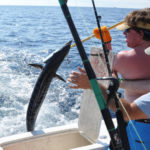
Wahoo provide bluewater fishermen out of Morehead City with plenty of Autumn action.
Tailgates. Pigskins. Orange leaves. Cool mornings. Bonfires. Hoodies. These are all signs of fall. For the offshore angler that pushes beyond the beaches on a cool, late September or early October morning, there is another marker of the changing of the season: wahoo.
Known as perhaps the fastest sportfish in the sea, wahoo, aka Acanthocybium solandri, are also known as some of the most vicious feeders, with teeth as sharp as scalpels and absolutely know fear of monofilament or other vulnerable tackle combinations. They swim in the deep, blue water and are highly sought for their table fare, representing one of the most cleanest, tastiest and textured fish that has ever met with fork and knife.
Oh, and they get pretty big. North Carolina’s state record the past 21 years has been a 150-pound fish.
Trolling is the only way to effectively catch wahoo. Think of a wahoo as an extremely-fast predator that likes to chase down its prey. Alan Scibal, first mate and sometimes captain of the charterboat Sensation — the first-ever hull turned out by Jarrett Bay Boatworks — spends most of September and October targeting wahoo out of Morehead City.
“They are strike-team pursuers,” said Scibal, who refers to September and October as the “best-of-the-year” fishing.
Targeting wahoo is about speed, clear water and keeping baits in the water.
“Where dolphin and marlin will attack baits that flip and flop, wahoo prefer baits to be in the water column, swimming nearly straight,” Scibal said.
When summer gives way to fall and its cooler weather, the offshore fishing grounds undergo a transition. Wahoo begin showing-up in the middle of August, and their numbers peak towards the end and middle of October.
“In years past, the peak wahoo fishing from was absolutely in October; however, in 2014, it seemed like we hit big wahoo in September, and October was less dramatic,” Scibal said.
For an angler fishing out of Morehead City, finding wahoo is all about pointing the nose of the boat toward the Continental Shelf and finding clean, blue water with little to no current, with an edge.
“Wahoo really prefer structure more than dolphin,” Scibal said. “When I am targeting wahoo, I am looking more at my depth chart for structure and my graph to mark bait. Wahoo are outliers and prefer to slice bait, not circling like billfish and not chasing everything that is shiny or moves like a dolphin. Where you look at surface sign for dolphin, billfish and tuna, for wahoo, think below the surface and think straight, even-pulled bait.”
Bait spreads and positioning is a matter of opinion, often driven by conditions and knowing what pulls best from a vessel considering wind, the sea and the speed. Scibal acknowledges that a typical fall charter will have a spread that includes the typical flat lines, short and long riggers, bridge pole and the go-to planer rod, pulled from the corner.
“My experience is that more than 90 percent of the strikes and connections I have with wahoo are from the bridge pole and the long riggers, followed by the planer rod,” said Scibal, who wants the rods in those three positions to pull the straightest, with baits in the water and not on top.
“These are the cleanest positions on the boat,” he said. “Wahoo appear — from what we know or think — to be sight-attackers, and with the speed they use to eat, it makes sense that their targeting a bait is about visual and timing. They just don’t have the characteristics to eat from out of the water like dolphin, tuna and billfish.”
Experience and time on the water suggest that wahoo prefer a color selection of baits of darker hues than other pelagics.
“I would definitely say that blue-crystal and purple-black and red-purple and red-black colors are very popular for wahoo,” Scibal said.
Because wahoo prefer to feed from below, the baits Scibal drops behind the boat are typically weighted heavier to keep them down in the water.
It is noted that has wahoo prefer to feed and eat from beneath the surface, the baits that Scibal dresses behind Sensation, are typically heavier weighted so that they will stay in the water.
“Obviously, any fish can and will eat any bait. What I’ve noticed is that the deeper the bait is in the water, the better the wahoo interest,” said Scibal, who prefers to rig wahoo baits with the traditional pin-rig style with ballyhoo and colored skirts from jet heads and the like.
“I use 9-wire as wahoo are very tooth-happy and inevitably slice through more monofilament than what are caught. Hook sizes are 8/0 or size 9/0, and color preferences remain darker colors. (But) the most-important thing, again, is straight, deep-tracking baits with wire as the terminal leader material.”
Scibal believes in using bigger ballyhoo than he rigs for other species.
“I really think the bigger ballyhoo are preferred and fish better than other baits; they add weight to the rig and they give more action when trolling,” he said.
Trolling speeds for wahoo tend to edge closer to the magical 7-knot mark, with pioneering anglers over the past few years developing high-speed wahoo techniques. When high-speed trolling, braided line, bent-butt combos are pulled with strike drag in the lower 30s and heavy weights forcing heavy planer tackle in the water while the boat is at near cruising speed in the upper teens to 20 knots. A lot of high-speed trolling takes place while en route to the fishing ground.
As the wahoo bite appears to swell and peak in the early fall, Scibal absolutely believes that there is a wahoo fishery in November, December, and January.
“The days that appear to be the best are when the Gulf Stream moves back closer to the break, and it’s a reachable distance,” he said. “If that occurs, and the water on the west side of the stream is cold and warmer water is adjacent, then those days can be phenomenal for wahoo fishing during late fall and early winter. Unlike fall fishing, when the Gulf Stream remains relatively close, you must assess water temperatures closely to make sure the run to the blue water is worth it when targeting winter wahoo.
Scibal believes in a philosophy that applies to most sportfishing interests: keep it simple.
“Wahoo fishing is about looking at the ocean from the bottom to the top,” he said. “In doing this, as wahoo hang in the water column and hunt with such force and aggressiveness, angling pursuits need to focus on keeping baits lined properly behind the boat and maintaining them in the water column, properly.”
When wahoo bite, anglers can expect blistering runs and speeds that rival any fish in the ocean. They don’t have the pulling torque of a tuna or marlin, but they have the thrust and energy of a drag racer. The longer the fight, the better the chances are for a wahoo to shake loose or slice its way free.
One of the best ways to tell that a wahoo is still on the hook as the leader approaches is the characteristic head-shaking a wahoo will exhibit in the later stages of a fight.
“There must be great care and safety in place when bringing a wahoo to the gaff; this is not a time for a photo opportunity. The fish need to go from gaff to box, quickly,” Scibal said.
Fall is one of the best times to bring meat from North Carolina’s bluewater to the freezer, then to fork and palate. Just as football, cooler nights and a good hoodie are signs of fall, a screaming reel is a true sign that fall fishing has arrived.
DESTINATION INFORMATION
HOW TO GET THERE — Morehead City is the gateway to offshore fishing in the Cape Lookout area. It is best accessed via US 70 from most places inland. Two popular public ramps are at the N.C. Division of Marine Fisheries headquarters on US 70 and on Town Creek in Beaufort.
WHEN TO GO — October is the peak of the fall wahoo bite in the bluewaters off Cape Lookout, although some fish will arrive in September, and a good number will remain through Thanksgiving.
BEST TECHNIQUES — Almost all wahoo caught off North Carolina hit trolled lures, either ballyhoo/sea witch combos trolled at the same speed the baits are trolled for dolphin, tuna and billfish, or lures speed-trolled several knots faster. Planers are commonly used to get wahoo baits below the surface; wire leaders are very common because of a wahoo’s sharp teeth.
FISHING INFO/GUIDES — Capt Dale Britt, Sensation, Morehead City, 252-725-5375, www.sensationsportfishing.com; Capt. Thomas Wood, Dancin Outlaw III, Morehead City,252-504-2342; www.dancinoutlw.net; zpg. Mike Webb, Pelagic Sportfishing, Morehead City, 252-904-3361, www.pelagicsportfishing.com. See also Guides and Charters in Classifiedsd.
ACCOMMODATIONS — Crystal Coast Tourism Authority, Morehead City, 252-726-8148, www.crystalcoastnc.org.
MAPS — iCapt. Segull’s Nautical Charts, 888-473-4855, www.captainsegullcharts.com; Sealake Fishing; Guides, 800-411-0185, www.thegoodspots.com; Maps Unique, 910-458-9923, www.mapsunique.com.





Be the first to comment